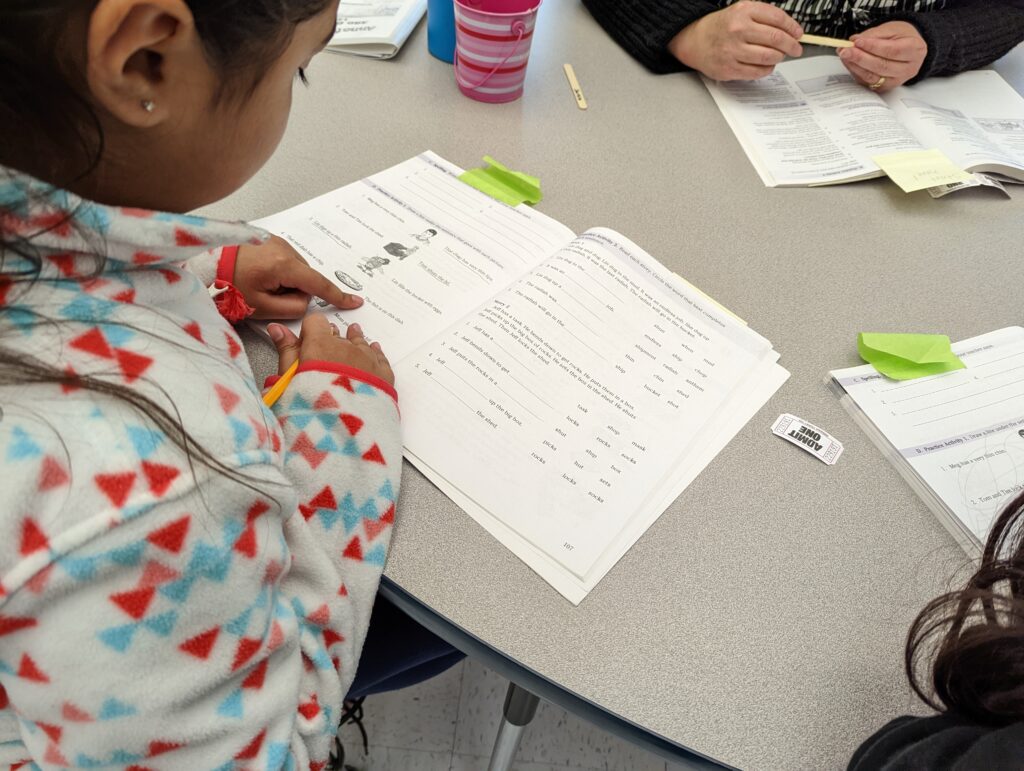Leaders of Salem’s teacher union had a goal in their recent contract negotiations: give the people who teach students more say in how schools run in the Salem-Keizer School District.
A tentative deal inked this week with district leaders does so, said Tyler Scialo-Lakeberg, president of the Salem-Keizer Education Association.
For the 40,000 students in local public schools, the result will be teachers who are better prepared for class and have more time to plan lessons that take students’ unique needs into account, she said.
Union and district leaders signed off on a tentative contract in the early hours of Tuesday morning after a marathon 17-hour bargaining session. The deal averted a strike which teachers voted overwhelmingly to authorize last week.
READ IT: Tentative agreement between the Salem-Kezier Education Association and Salem-Keizer School District
Note: The agreement is still being proofread by the district and edited for formatting.
They settled on a 9.75% pay increase for teachers over two years, more money toward health insurance, a one-time $6,000 retention bonus, and detailed language spelling out the hours and workload expectations for full-time teachers.
The increases would bring the starting salary for a district teacher with a bachelor’s degree to $48,320 this year, and for a teacher with five years of experience and a master’s degree to $63,785.
The deal will cost the district about $42.5 million over the next two years, with $19.3 million of the total going toward the retention bonus. The bonus money comes from federal Covid relief money that must be spent this year.

The definition of workload for a full-time teacher, and language around class size, were the final sticking points in negotiations after pay and other fiscal issues were largely settled earlier this year. The union significantly scaled back its class size proposals, which initially included overage pay for teachers of larger classes.
The final agreement gives the union the ability to make class size recommendations during the annual budget process and focuses reduction efforts on elementary school classrooms, with a joint district and union committee to review data on teacher to student ratios.
“We have been talking about this all year — our class sizes took years to get this large. It will take years to start reducing them. Our goal is to get some class size and caseload language into our contract as a starting ground,” Scialo-Lakeberg said.
She said the new contract builds in some accountability around targets that have long existed for elementary classrooms, requiring the district to act when classes are too large by hiring additional help, moving students or, if no other action is taken, paying teachers more.
“We’re back at the table next year and this will be a high priority,” she said. “This is going to be our ongoing priority for every bargain until we get down to manageable class sizes and caseloads in this district.”
Superintendent Andrea Castañeda said Tuesday she was filled with “relief and gratitude” that both sides worked hard to get an agreement.
“it is a representation of what our community is, which is one that wants to solve problems, not create them,” she said.
A long negotiation
Though the superintendent and her annual $285,000 salary have been derisively referenced on picket signs for months during negotiations, Scialo-Lakeberg said bargaining improved once Castañeda joined mediation personally and pushed other district leaders to make progress.
“When she turned her focus to that, it was like, ‘Let’s get this done,’” Scialo-Lakeberg said Wednesday. “We appreciate that.”

Negotiations were arduous in part because the union opened every article of the contract to bargaining, not just pay and benefits. That means policies ranging from grievance procedures to work schedules were up for tweaks.
The union’s previous contract, bargained during Covid, touched only pay and insurance contributions. Scialo-Lakeberg said it didn’t make sense to push for larger changes when nobody knew what school would look like in the wake of a pandemic.
Budget cuts and the layoff of hundreds of educators loom for the district in the coming months.
Castañeda reiterated Tuesday that she plans to cut another $30 million from next year’s district budget — a target that will mean hundreds of layoffs that will touch every school. That comes after December cuts totaling $31 million.
She plans to seek school board approval in April for a workforce reduction.
But many of the new pieces in the contract have little impact on teacher pay or the district’s budget. They include having more educator participation in committees, teachers in leadership roles in every school and a more proactive approach to identify solutions to students who are acting out in class, injuring teachers and educators.
“Our members can give input into decision making on a variety of things from student behavior to curriculum,” Scialo-Lakeberg said. “The idea is for our district leaders to listen to those who are doing the job to make sure we’re getting it right.”
The contract must be ratified by a majority of the union’s members, as well as the school board. Scialo-Lakeberg said she expects members to support it, and said overall they’re getting overwhelmingly positive feedback despite the compromises made.
When teachers return from spring break next week, the union will hold several all-member meetings so people can drop in, learn about the agreement and ask questions.
Scialo-Lakeberg says they hope to have a member vote in time for the school board to approve the contract at their April 9 meeting.
Teacher input and planning time
Several changes in the contract will give teachers more time in their day to plan lessons, grade papers and collaborate with other teachers, replacing time that had previously been mandatory meetings or professional development.
Scialo-Lakeberg said that’s an important step toward teachers having a manageable workload and being better prepared to help students when they show up to class.
Since schools returned from Covid closures, she said the effort to catch students up academically has resulted in a whirlwind of meetings, trainings and data reviews, with little time for teachers to implement what they’re learning, reflect or stay on top of their day-to-day work.
“By no means are we saying we don’t value collaborative time or we don’t value looking at student data,” Scialo-Lakeberg said. But she said the focus has become unbalanced.

Schools in the district start late on Wednesdays to give teachers time for professional development. That time has so far been district-directed, meaning teachers are required to be in specific meetings or training.
For the rest of the school year, only one Wednesday per month will be district directed. The others are free for teachers to use the time as they see fit, which could mean contacting families, planning lessons, or talking to other teachers about how to address challenges in the classroom.
“Our educators don’t have the time within their workday to do those things. That is pushing more and more educators to the brink of exhaustion and also quitting because their primary job is pushed off to the side,” Scialo-Lakeberg said.
Next school year, Wednesday morning time will be split: half for teachers to plan and work as they see fit, and half directed by the district.
Scialo-Lakeberg said students will see benefits from those changes in teachers who are more prepared for class and able to better tailor lessons to the range of students in the room.
Elementary school teachers will have an additional hour per week of preparation time.
Schools will also have a new “teacher leader” position, allowing educators to do extra work like mentoring new teachers, helping with scheduling and weighing in on training.
The position comes with $2,500 per year in additional pay.
Student behavior and safety
Multiple parts of the contract address the growing issue of educators being assaulted and injured by students, with some intended to prevent behavioral problems from escalating to violence in the classroom.
The contract requires administrators to notify classroom teachers if one of their students is placed on a behavior plan and to be given a copy of that plan.
It also provides that schools will take a collaborative approach when a student’s behavior poses a safety risk to others, requiring a meeting that includes teachers and other school employees who work closely with the student to discuss how to improve the situation.
“It’ll also get that child interventions sooner rather than later,” Scialo-Lakeberg said.
Educators injured on the job can seek worker’s compensation, but there’s a three-day waiting period for benefits to kick in. The contract requires the district to pay educators for those three days so workers injured by students don’t have to use their sick leave or go without pay to recover.
Contact reporter Rachel Alexander: [email protected] or 503-575-1241.
SUPPORT OUR WORK – We depend on subscribers for resources to report on Salem with care and depth, fairness and accuracy. Subscribe today to get our daily newsletters and more. Click I want to subscribe!

Rachel Alexander is Salem Reporter’s managing editor. She joined Salem Reporter when it was founded in 2018 and covers city news, education, nonprofits and a little bit of everything else. She’s been a journalist in Oregon and Washington for a decade. Outside of work, she’s a skater and board member with Salem’s Cherry City Roller Derby and can often be found with her nose buried in a book.










